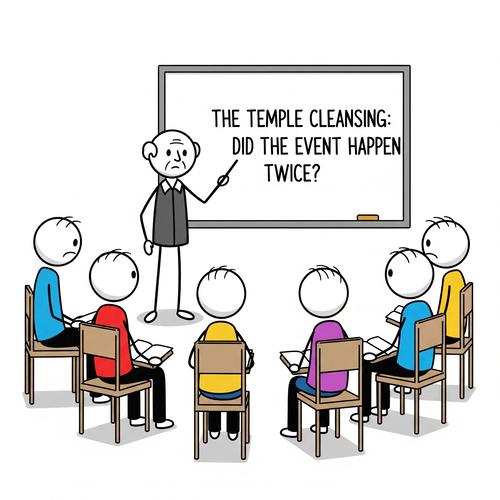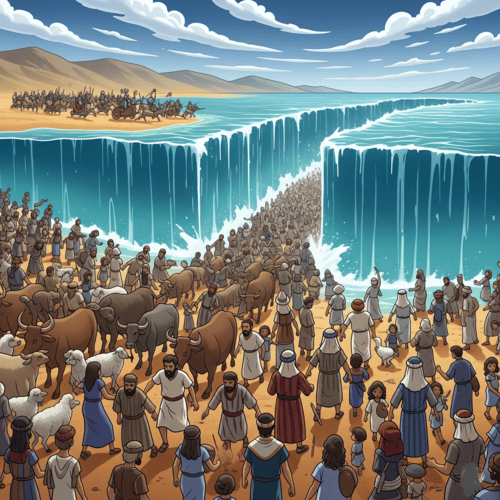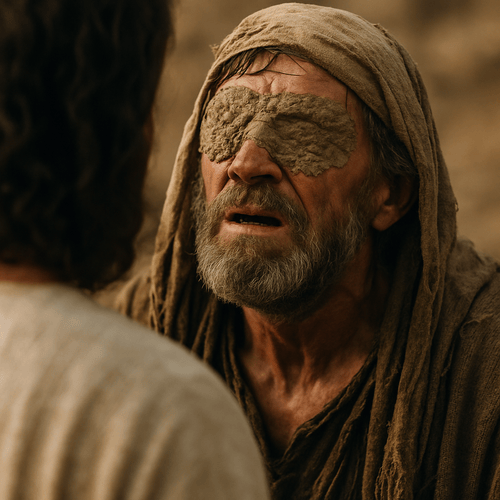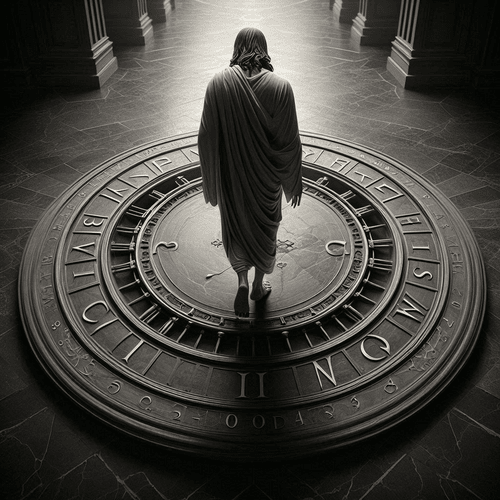John 9 Explained: Why Did Jesus Use Spit and Mud to Heal?
Modern readers find Jesus’s healing technique in John 9 deeply troubling, even off-putting. Spit and mud? Really? It seems crude, perhaps even insulting to our sanitised sensibilities. But here’s the thing—was the blind man complaining? Not for a second. While we might wrinkle our noses, he was too busy experiencing the miracle of sight to worry about the method.
The Reformed tradition offers profound insights into why the Lord of glory chose such an earthy approach to restore a man’s vision. Far from being arbitrary or crude, Jesus’ actions reveal deep theological truths about His nature, His kingdom, and His purposes.
DEMONSTRATING LORDSHIP OVER THE SABBATH
First and foremost, Jesus was making a bold statement about His authority. By healing on the Sabbath—and doing so through what the Pharisees would consider “work” (making mud, applying it, commanding the man to wash)—Jesus asserted His lordship over the Sabbath itself.
As Matthew Henry observed, Christ showed He was “Lord of the Sabbath” by doing good on it, despite the religious leaders’ objections. The healing wasn’t just about the blind man’s sight; it was about revealing Jesus as the One who authored the Sabbath and therefore had authority to define its proper observance. The mud and spit became instruments not just of physical healing, but of theological declaration.
DEMONSTRATING SOVEREIGNTY IN CHOICE OF METHODS
Scripture also emphasises God’s sovereign choice to work through means rather than always acting through direct, immediate intervention. John Calvin noted that while Jesus could have healed with a mere word (as He did elsewhere), He chose to use physical elements to accomplish His purposes.
This demonstrates several crucial truths.
- It shows God’s freedom to work however He pleases—He’s not bound by our expectations or preferences for how miracles “should” happen.
- It reveals God’s willingness to sanctify and use even the most ordinary, humble materials for extraordinary purposes. The same God who spoke creation into existence chose to work through mud and saliva, elevating the mundane to serve divine purposes.
Calvin also suggested this method taught the man (and should teach us) not to despise God’s chosen means, however humble they might appear. Faith sometimes requires us to embrace methods that seem foolish to human wisdom.
POINTING TO GREATER SPIRITUAL REALITIES
The physical healing in John 9 also serves as a powerful metaphor for spiritual regeneration.
Just as God formed Adam from the dust of the earth, Jesus formed mud to restore what sin had damaged. The symbolism is unmistakable—this is a new creation moment, pointing to the spiritual re-creation that occurs when Christ opens spiritually blind eyes.
The Pool of Siloam, where the man was commanded to wash, means “sent”—the very word John uses to describe Jesus Himself. The healing required obedience to Christ’s command, paralleling how spiritual sight comes through faithful response to the gospel call.
HUMBLING HUMAN PRIDE AND WISDOM
Reformed theology recognises God often chooses “the foolish things of the world to shame the wise” (1 Corinthians 1:27). By using such an unexpected method, Jesus confronted human pride and preconceptions about how God should work.
The religious leaders were scandalised not just by the Sabbath healing, but by the undignified method. Their reaction revealed hearts more concerned with maintaining religious propriety than celebrating God’s mercy. Meanwhile, the former blind man became an unlikely theological victor, defending Jesus against learned Pharisees.
This pattern runs throughout Scripture and Reformed teaching—God delights in using humble means to accomplish great ends, often to the embarrassment of those who think themselves wise.
TESTING AND BUILDING FAITH
Some Reformed commentators suggest Jesus used this method to test and strengthen the blind man’s faith. It would have taken considerable trust to allow a stranger to put mud on your eyes, then walk to Siloam to wash.
The man’s obedience demonstrated the kind of simple, childlike faith that Jesus consistently praised. The man didn’t demand explanations or cleaner methods—he simply obeyed and was healed.
THE ULTIMATE REVELATION
Perhaps most significantly, this healing served as a sign pointing to Jesus’ identity as “the light of the world.” The physical restoration of sight proclaimed the arrival of the One who’d give spiritual sight to those dead in sin.
The method mattered less than the miracle, and the miracle mattered less than the message: God had visited His people in the person of Jesus Christ.
So the next time we read John 9, let’s not get hung up on the spit and mud. Let’s focus instead on the stunning reality they represent—the God of the universe, willing to get His hands dirty (literally) to restore what sin had broken. That certainly didn’t seem crude to the blind man—it was beautiful. And so it should be for us—who, like him are the beneficiaries too.
WHY DID JESUS USE SPIT AND MUD TO HEAL? RELATED FAQs
Why didn’t Jesus just speak the healing like He did for other blind people? DA Carson suggests Jesus varied His methods to demonstrate His complete freedom and sovereignty in how He works. Each healing served different theological purposes—here, the physical process emphasised the man’s need for active faith and obedience. John MacArthur notes Christ’s diverse methods prevent us from creating formulaic expectations about how God must work.
- Wasn’t using saliva considered unclean or degrading in Jewish culture? While saliva wasn’t inherently unclean under Mosaic law, it could be in certain contexts (Leviticus 15:8). However, Reformed theologians like John Chrysostom historically argued Jesus was demonstrating His authority over ceremonial cleanness—what mattered wasn’t ritual purity but divine power. The late James Montgomery Boice emphasised Jesus regularly transcended cultural taboos to show the kingdom’s higher priorities.
- Did Jesus need the mud and saliva, or was this just for show? Scripture reveals Jesus didn’t need any physical means—His divine power was sufficient alone. RC Sproul taught Christ chose to use means to show His identification with the created order and His willingness to work through ordinary materials. Sinclair Ferguson adds this demonstrates how God sanctifies the physical world for spiritual purposes rather than despising it.
Some claim this proves Jesus was just a faith healer using psychological tricks. How do we respond? Reformed scholars reject this naturalistic explanation entirely, pointing to the man’s lifelong blindness (v 1) and the Pharisees’ inability to deny the miracle’s reality (v. 16). John Piper notes psychological healing can’t create eyes or restore congenital blindness—this required genuine divine intervention. The subsequent interrogations by religious authorities confirm this was an undeniable supernatural act, not mere suggestion or placebo effect.
- Why didn’t Jesus heal the man’s spiritual blindness at the same time as his physical blindness? John Calvin observed spiritual illumination often comes gradually, as demonstrated by the man’s progressive understanding of Jesus (from “man called Jesus” to “prophet” to “Lord”). Kevin DeYoung adds this shows how faith typically develops through experience and reflection. The delayed spiritual revelation also allowed Jesus to teach about judgement and blindness in verses 39-41.
- Does this healing support the “prosperity gospel” idea that physical healing always accompanies faith? Reformed theology strongly rejects this interpretation. John MacArthur emphasised Jesus’ healings were primarily signs of His messianic identity, not promises of universal physical healing for believers. Tim Keller noted that while God sometimes heals physically, the primary healing Christ offers is spiritual—deliverance from sin and death. The man’s healing was exceptional, not normative for every believer’s experience.
Why did Jesus tell him to wash in the Pool of Siloam specifically? Beyond the symbolic meaning (“sent”), Reformed commentators see practical purposes in this command. Matthew Henry suggested it tested the man’s faith and obedience while providing public verification of the miracle. RC Sproul noted that washing in a known public place ensured multiple witnesses to the healing’s authenticity. The specific location also connected the miracle to Jerusalem’s water system, possibly alluding to Jesus as the source of living water (John 7:37-38).
WHY DID JESUS USE SPIT AND MUD TO HEAL? OUR RELATED POSTS
Editor’s Pick

Sacred Fury: What Christ’s Temple Cleansing Truly Means
Mark 11 records the crack of a handmade whip that echoed through the temple corridors. Tables crashed to the ground, [...]

Did Jesus Cleanse the Temple Twice?
OR DID JOHN DISAGREE WITH THE SYNOPTICS ON TIMING? One of sceptics’ favourite "gotcha" questions targets what they see as [...]

Self-Authentication: Why Scripture Doesn’t Need External Validation
"How can the Bible prove itself? Isn't that circular reasoning?" This objection echoes through university classrooms, coffee shop discussions, and [...]

The Racial Diversity Question: Does the Bible Have Answers?
Walk into any bustling metropolis today and you'll likely witness humanity's breathtaking diversity—the deep ebony skin of a Sudanese family, [...]

Do Christians Need Holy Shrines? Why the Reformed Answer Is No
Walk into a medieval cathedral and you'll encounter ornate shrines, gilded reliquaries, and designated "holy places" where pilgrims gather to [...]

If God Is Sovereign, Why Bother Praying?
DOESN’T DIVINE SOVEREIGNTY OBVIATE PRAYER? **Editor’s Note: This post is part of our series, ‘Satan’s Lies: Common Deceptions in the [...]

I Want To Believe, But Can’t: What Do I Do?
"I want to believe in God. I really do. But I just can't seem to make it happen. I've tried [...]

BC 1446 or 1250: When Did the Exodus Really Happen?
WHY REFORMED SCHOLARS SUPPORT THE EARLY DATE Many a critic makes the claim: “Archaeology has disproven the biblical account [...]

Does God Know the Future? All of It, Perfectly?
Think about this: our prayers tell on us. Every time we ask God for something, we’re confessing—often without realising it—what [...]

Can Christian Couples Choose Permanent Birth Control?
Consider Sarah, whose fourth pregnancy nearly killed her due to severe pre-eclampsia, leaving her hospitalised for months. Or David and [...]





